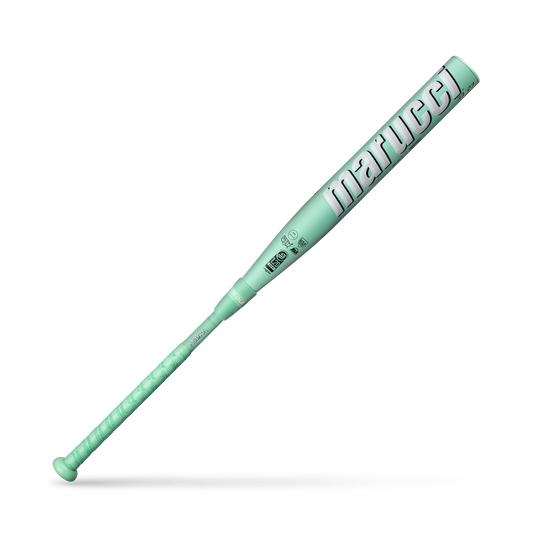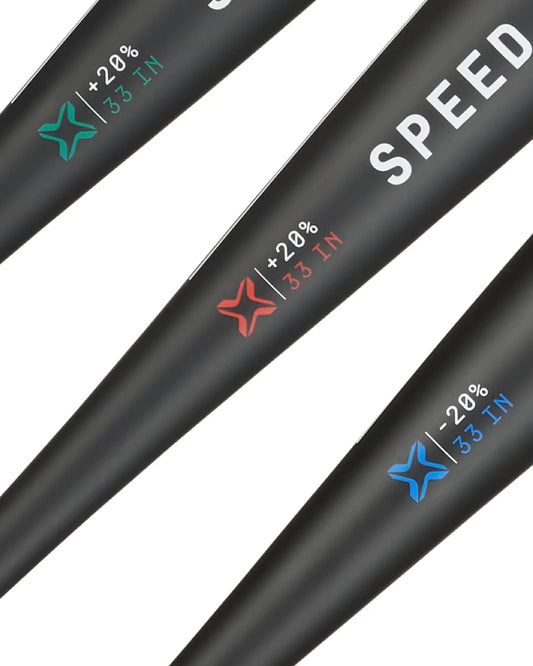Softball Bats Buying Guide

Bat Anatomy
KNOB: Helps keep the bat from slipping out of a batter's hand; Also helpful for hanging on a bat rack for storage
GRIP: Typically covered by tape or a bat gripping aid, this is where a batter will place his or her hands when swinging
TAPER: This section is where the thin handle transitions into the wider barrel
BARREL: The thickest area of the bat where a batter should look to make contact with a baseball or softball
END CAP: Finishes off the barrel; Often helps increase control while limiting the bat's overall swing weight
Drop Weight
Every fastpitch and t-ball bat has a weight and "drop" weight. Bat weights are shown in ounces, while drop weights are shown as negative numbers
The drop weight is determined by subtracting the weight of the bat from its length
For example, a bat that’s 30 inches long and weighs 20 ounces will have a drop weight of -10.
The larger the drop weight, the lighter the bat
For example, a bat with a -13 drop weight is lighter than a bat with a -10 drop weight.
Lighter bats are often best for beginners and smaller, contact-oriented players. Heavier bats are better suited for older, advanced athletes and larger, power-hitting players
Adult Slowpitch Bats do not have drop measurements. Instead, Slow pitch players will need to determine which weight to select, beginning at 24 oz and as heavy as 30 oz
GUTSY'S PRO TIP: To determine if a bat is too heavy, here's one simple trick. Hold the bat handle and extend your arm away from your side. If you can't hold the bat extended for 30-45 seconds, the bat might be too heavy for you.
Bat Material
The life and performance of a bat is largely determined by the quality of its materials. There are three common bat materials found in performance bats.
COMPOSITE
Composite bats feature a layered carbon fiber or graphite material in the barrel that yields a powerful pop, minimized vibration (or “sting”) on contact and large sweet spot, but typically will cost more and requires a break-in period before use. Composite often feels lighter and is easier to swing than alloy, especially for younger players.
Price: $$$
Break-In: Required; Roughly 150-200 hits
Weather Conditions: Not recommended below 65 degrees
Vibration: Reduced vibration; clean and smooth feel on contact
Sound: Crack, like a piece of wood
GUTSY'S PRO TIP: For optimal break-in, rotate the bat a quarter turn with each swing, and increase the power level gradually
METAL ALLOY
Metal Alloy bats are durable, versatile and offer a balanced feel. They are usable in any weather condition and require no break-in period. But alloy bats may feel a little heavier for younger players, especially those with double wall barrels - and they tend to have a smaller sweet spot and less pop than composite. More advanced players who have learned to make contact with a smaller sweet spot may prefer the balanced feel of alloy that can lead to faster swing speeds.
Price: $
Break-In: Ready out of the wrapper
Weather Conditions: Any
Vibration: Some Vibration and sting felt on mis-hits
Sound: Ping
GUTSY'S PRO TIP: Not all alloy blends are created equal! This will lead to a variation in price on all alloy bats
HYBRID
Hybrid or "Half & Half" bats typically feature a composite handle and metal alloy barrel to give athletes the durability and “hot out of the wrapper” performance of metal with the lighter feel and sting-reducing benefits of composite.
Price: $$
Break-In: Ready out of the wrapper
Weather Conditions: Any
Vibration: Some vibration and sting felt on mis-hits, but this can be minimized thanks to the composite handle
Sound: Ping
GUTSY'S PRO TIP: if you love the feel of an alloy barrel but desire a lower swing weight, look for a hybrid bat with composite end cap!
Comparisons
ONE-PIECE BATS
Continuous material with no break points between the barrel and handle. By eliminating break points, one-piece bats store more energy upon point of contact, thus increasing power. One-piece bats are typically less expensive as they are easier to produce. They also offer an extra stiff feel and limit flex on impact
VS.
TWO PIECE BATS
Constructed with a special bonding process between the barrel and handle, two-piece bats, generally, offer a greater amount of flex when connecting with the ball, producing a “whip” effect that boosts bat speed. Two-piece bats are typically more expensive, but can also help limit sting and vibration on mis-hits
------------------------------------------------------------------------------------
BALANCED BATS
Weight is evenly distributed throughout the entire length of the barrel for a faster swing speed. Balanced bats are more common and can be easier for most players to swing
VS.
END-LOADED BATS
End-loaded bats have added weight towards the end of the barrel, helping power hitters achieve more momentum and distance with every swing
Determining your Ideal Bat Length
For fastpitch players, determining the right length of bat is critical to achieving proper swing mechanics and results at the plate. Too long, and you can risk compromising bat speed or accuracy. Too short, and you can limit your plate coverage, giving up a portion of your strike zone.
NOTE:Nearly all Adult Slow PItch Bats will have a length of 34"
1. Place the bottom of the bat in the center of your chest, pointing it to the side, parallel to your outstretched arm. If you can comfortably reach the top of the bat with your fingertips, the bat is the right length
2. Position the bottom of the bat in the center of your chest, facing outward. If your arm can reach out and grab the barrel of the bat, then it is the correct length
3. Stand the bat up against the side of your leg. If the end of the bat reaches the center of your palm when you reach down, it’s the appropriate length
Softball Leagues and Certifications
WOMEN'S & GIRLS' FASTPITCH
Ages: 7 - Adult
Drop Weights: -8 through -13
Bat Lengths: 27" through 34"
Stamps(s): USA (formerly ASA) , USSSA, NSA, ISA
Most fastpitch bats will have a balanced swing weight. Certification stamps will remain the same throughout a fastpitch player's career, regardless of age.
GIRLS SLOWPITCH & TEE BALL
Ages: 8 and younger
Drop Weights: -10 through -13.5
Bat Lengths: 24" through 32"
Stamps(s): USA (formerly ASA) , USSSA, NSA, ISA and USA for T-Ball Only
Tee Ball players and beginner softball athletes should use a lighter bat with a -12 or -13 drop weight, while older youth athletes can move to -10 or -11 based on their size. Tee Ball bats will be stamped with a USA certification logo.
ADULT SLOWPITCH
Ages: 18+
Weights: 24oz-30oz
Barrel Lengths: 12-14"
Bat Lengths: 34"
Stamps(s): USA (formerly ASA) , USSSA & SSUSA (Senior), NSA and ISA
Nearly all Adult Slowpitch Bats will have a length of 34," but weights within will vary. For contact/gap hitters, it may be best to choose a bat weight of 26 or 27 ounces. Athletes seeking maximum power and distance at the plate should opt for the heavier weights of 28 or 30 ounces.
Collection: Softball Bats
-
MARUCCI ASURA Fastpitch -8
Vendor:Gutsy AthleticRegular price $449.99 USDRegular priceUnit price / per -
MARUCCI ASURA Fastpitch -9
Vendor:Gutsy AthleticRegular price $449.99 USDRegular priceUnit price / per -
MARUCCI ASURA Fastpitch -11
Vendor:Gutsy AthleticRegular price $449.99 USDRegular priceUnit price / per -
MARUCCI ASURA Fastpitch -10
Vendor:Gutsy AthleticRegular price $449.99 USDRegular priceUnit price / per -
MARUCCI Soul Fastpitch Alloy -11
Vendor:Gutsy AthleticRegular price $79.99 USDRegular priceUnit price / per -
Axe Speed Trainers Bat Set powered by Driveline Baseball
Vendor:Gutsy AthleticRegular price $499.99 USDRegular priceUnit price / per






